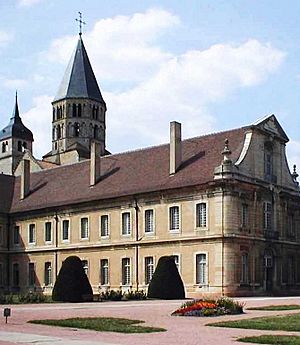Cluniac Reforms facts for kids
The Cluniac Reform was a big movement that brought many changes to monasteries in the Middle Ages. Monasteries were places where monks lived and prayed. This reform aimed to bring back the original, strict rules for how monks should live. It also encouraged monasteries to create beautiful artworks and help people who were poor.
Contents
What Was the Cluniac Reform?
The Cluniac Reform gets its name from the Cluny Abbey in a region of France called Burgundy. This abbey was a very important monastery. The reform began there within the Benedictine order, which was a group of monks following specific rules. A key leader of this reform was Saint Odo. The ideas of the Cluniac Reform quickly spread across France, including areas like Provence and Auvergne. It also reached England, Italy, and Spain.
Why Was Reform Needed?
The Cluniac Reform started because people felt there was a lot of corruption in the Benedictine monasteries. Corruption means that people were not following the rules or were doing things for selfish reasons. Many thought this problem happened because people from outside the monasteries, who were not priests, were getting involved in their business.
Monasteries needed land to grow food and support themselves. This land was often given to them by a powerful local lord, who was part of the feudal system. When a lord gave land, he became the monastery's patron. This meant he often demanded the right to control what happened inside the monastery. This interference could make it hard for the monks to follow their rules properly.
How Did Cluny Become Independent?
The Cluny Reform tried to stop this outside interference. The idea was that if an abbot (the head of a monastery) was more independent, he could do a better job of making sure the monks followed their rules.
A very important step happened in 910. A powerful lord named William I of Aquitaine started the first Cluny monastery. He added a special rule: this monastery would report directly to the pope (the leader of the Catholic Church) instead of a local lord. This was a big deal! It meant the monastery was mostly independent. The pope was far away, so his authority didn't usually involve day-to-day control. This allowed Cluny to run its own affairs without local lords telling them what to do.
The Impact of the Cluniac Movement
At its strongest, from about 950 to 1130, the Cluniac movement was one of the most powerful religious forces in Europe. Many important people supported it, including Pope Urban II and other religious leaders.
The Cluniacs also supported ideas like the Peace and Truce of God. This was an effort to reduce fighting and violence in society. They also encouraged pilgrimages, which are journeys to holy places, especially to the Holy Lands.


